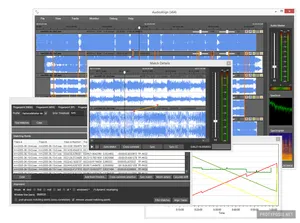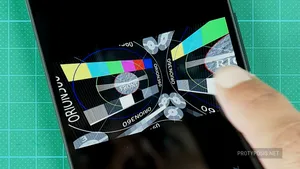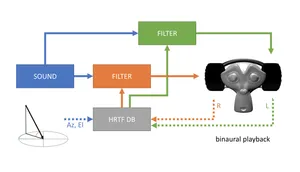Local Audio Broadcast released
Local Audio Broadcast is a simple application that captures the local audio playback in Windows and streams it to a UPnP renderer on the network.
Showing Posts From
Local Audio Broadcast is a simple application that captures the local audio playback in Windows and streams it to a UPnP renderer on the network.
This is the accompanying website for the paper presented at MMM 2015, providing the download of the synchronization ground truth for the Jiku dataset.
New publications page with links and downloads to my scientific publications.
The ITEC MediaPlayer library for Android has been updated to 1.4.0. This new version mainly improves DASH support, but also has a few bugs fixed, small changes and additions to the MediaPlayer/VideoView API, and improved error/exception reporting.
I am currently trying to solve licensing issues on an unreleased project I am working on and want to get rid of all dependencies under the GPL. One of them is the libsamplerate resampling library, which I have been using for a few years through a managed .NET wrapper. It is just a small wrapper library, but it proved to be working stable. Since I could not find […]
The UA-5 is a rather old audio interface and no longer supported by Edirol. The Windows 7 driver doesn’t work with newer Windows versions, and the alternative of editing the INF file is cumbersome and requires disabling the driver signature enforcement (which is not recommended). There is a surprising solution though.
Conducting high precision audio drift or audio frequency measurements doesn’t have to be expensive. In this guide, I’m showing you how to do it with an ordinary computer, an audio interface, a GPS receiver, and a bit of tinkering.

AudioAlign is a tool that I started developing in 2010 for my master’s thesis (and have been actively developing since then), with the goal to create a software for the automatic synchronization of audio and video recordings. Although I never quite reached the point of a fully automatic synchronization system, it showed promising results compared to the few similar commercial applications available on the market, and continues to be a helpful tool for my research purposes. I gave up on the plan to commercialize it due to patenting problems I didn’t know how to deal with, but instead decided on open sourcing it, so others can make use of it and hopefully even help me improve it.
Aurio is a library extracted from AudioAlign, providing the underlying core audio processing functionality, including audio fingerprinting and time warping algorithms. Both Aurio and AudioAlign are now available on GitHub under the AGPL license.
Yesterday I discovered the free TVUnblock.com service and was suprised how easy it is to use. Configuring my OpenWRT router to get access to US Netflix content only took me about 5 minutes. Being a free service, TVUnblock requires users to register their IP with them to unlock the unblocking functionality. For internet connections with dynamic IP adresses, this means that you have to regularly re-register your IP address, else you’re back to the local program, or none at all if you use it for services that aren’t available outside the US.
Since the previous post from about a year ago, the ITEC MediaPlayer for Android has evolved to its second major version, receiving a lot of bugfixes, a rewritten playback core with huge performance improvements, and the ability to playback audio-only sources. Its new name now bumps it to version 3.0, and it is reaching a point where I feel confident that it can be used in production. In fact, people are already starting to use it.

Protyposis Multimedia Solutions is the label under which I provide professional software development services in the multimedia domain.

LAIS.Foto is a voluntary project that I developed a few months ago for a friend. It’s a self-hosted online photo sharing platform with community features, similar to Flickr. Compared to other existing platforms, it features a unique upload and download workflow with an intermediate moderation step, tailored to the principle of donating and requesting pictures.

Spectaculum is a view widget for Android to display visual content in a GLES accelerated context, providing zooming and panning functionality, parameterized shader effects, and frame grabbing. It comes with additional views that save developers a lot of time and implement all functionality for displaying bitmap images, camera preview, and videos through the Android MediaPlayer, MediaPlayer Extended, and ExoPlayer. The packaged shader effects range from simple color filters to immersive 360° VR video rendering.

Playback of immersive 360° video on Android is usually done in a WebView with an HTML5 video player. This tutorial demonstrates how to display 360° video in a native view widget to save the overhead of a whole browser stack. This is done by using the versatile Spectaculum view widget for video rendering and the popular ExoPlayer for video decoding. Both of these libraries are open source under the Apache 2.0 license and available on GitHub and the JCenter repository.

This October I talked about spherical audio for 360°/VR videos at Demuxed, a conference for video engineers. I explain the principles of the Ambisonics surround sound technique from recording to playback through a speaker array or headphones with binaural playback, and how it can be used in web applications and video players through the Web Audio API.

A collaboration with eyecandylab, a company developing products for augmenting TV programs, recently gave me the opportunity to implement great new features into Aurio. The most recent version released today extends the architecture to support processing of real-time audio streams with infinite lengths, which means that live streams can now be fingerprinted on the fly with minimal latency. Additionally, the Aurio core library has been ported to .NET Standard 2.0 and will run with the .NET Core 2.0 framework on Windows, Linux and MacOS, enabling building microservices in containerized environments like Docker.
Two years ago I was approached by someone from a public TV broadcaster in Germany with the following problem: Given multiple video files with differently cut versions of the same production, is it possible to use the technology from AudioAlign/Aurio to automatically generate edit decision lists (EDL/XML) and use them to transfer subtitles from a reference version to the different cuts? The answer is “yes”, and that’s just one of many use-cases. This article describes the challenges and how Aurio solves them almost magically in a successful prototype developed for the TV station.

Aurio version 4, released yesterday, is a significant update that brings a host of modernizations and improvements. It is now available in the NuGet Gallery, features an updated build setup, improved cross-platform support, FFmpeg compatibility on Linux, new functionalities, optimizations, and numerous bug fixes.

In this talk at the Demuxed 2022 conference for video engineers, I explain how my team and I transformed the testing process of the Bitmovin Video Player and scaled test executions from hundreds to millions.